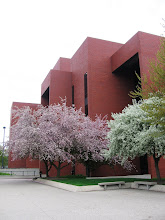by Marcy L. Simons, Head of Access ServicesThe American Library Association’s Mid-Winter conference has long been a staple for the “think-tanks” behind the association, its members, and committees. Unquestionably, the theme of this year’s mid-winter was budget-cuts and how to deal with them.
Whether in a discussion with colleagues, during a more formal presentation, or in round-table discussion groups, an item on every agenda was how to deal with shrinking budgets.
The attendance numbers have been confirmed – 7,905 actual attendees – a far cry from the almost 11,000 who registered for the conference. Cancellations of discussion groups, panel sessions, and committee meetings were many due to panel members not able to travel, and, even in some cases, chairpersons having to give up their positions because they would not be able to attend the 2009 conferences.
As so many of our colleagues commented, there is strength in numbers, and there is no better way to jumpstart creativity than by spending time with like-minded people who all have the same goal: providing information and services that our users need and want. On everyone’s agenda was the question of how libraries prepare for, and implement, budget reductions while still taking advantage of future trends to support student and faculty research and learning. Below is a brief list of some of the interesting take-aways that I heard.
Librarians should anticipate an insistence on data management for all types of libraries. For academic libraries, this means measuring our impact on the educational experience of our users.
Today’s practicing librarians have a stake in what is being taught to future librarians in our graduate library schools. The curriculum needs to include course topics such as the following:
- evaluation of library services using well understood metrics
- evaluation of the “user experience”
- community service
- “each one reach one” mentoring programs
- library service advocacy
Librarians need to become more experienced at advocating for their library’s programs and services. In addition to receiving training to accomplish this, practicing librarians at all levels need to get out among their community of members to inform people about libraries and the services available to them.
Librarian administrators, deans, and public service directors spoke about various ways to manage budget reductions. Some of the more creative ways were the following:
- shared print repositories and consortia making “group” collection decisions
- creating formal assessment tools/programs to answer the “how do you provide
value” questions coming from boards, trustees, and others
- using today’s uncertainties as a qualified opportunity for reevaluating programs
and services and for re-structuring and right-sizing for organizational efficiency
There is more interest on developing an interface to efficiently deliver more mobile content for small-screen mobile devices such as the iPhone or iTouch, Blackberry, PDAs, smart watches, and other devices with restricted processing, memory, screen size, and bandwidth.
Librarians need to direct more attention to enhancing and evaluating the user’s library experience by actively employing collection techniques that go beyond placing posters throughout the library soliciting comments.
As a new professional to librarianship, the most important thing I learned was the importance and value of practicing librarians sharing our stories among each other so that we can capitalize on our successes for providing library programs and services.
Labels: ALA conference, Ball State University librarians, reflections





